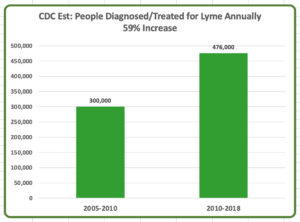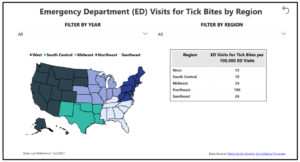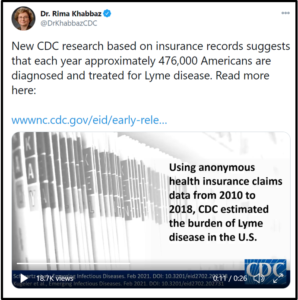
SHARE THIS ARTICLE:
New Estimates of People Diagnosed/Treated for Lyme: 476,000 Annually

476,000 People Diagnosed & Treated for Lyme Annually: The Centers for Disease Control and Prevention (CDC) published in the February edition of its Emerging Infectious Diseases two new papers pertaining to Lyme disease.
CDC states on its How Many People Get Lyme Disease? webpage (reviewed Jan 13, 2021), “A recently released estimate based on insurance records suggests that each year ~ 476,000 Americans are diagnosed & treated for Lyme disease.1,2 This number is likely an over-estimate of actual infections because patients are sometimes treated presumptively in medical practice. Regardless, this number indicates a large burden on the health care system and the need for more effective prevention measures.”
The researchers found ~ 476,000 people are diagnosed with and treated for Lyme disease each year in the U.S. The prior Lyme estimates by CDC from 2005 to 2010 indicated “~300,000 people get Lyme disease each year.” Both estimates are based in part on insurance claim data. Based on CDC’s estimates the LDA calculated a 59% increase in the estimated number of people diagnosed & treated for Lyme disease annually. (See Fig. 1)
The CDC clearly states on its website, “It’s important to emphasize that 476,000 is the estimated number of people treated for Lyme disease and likely includes some patients who were not actually infected.” Read the two papers below for their discussion on this new estimated number.
The two 2021 research papers on which the new 476,000 estimate is based are:
- Schwartz AM, Kugeler KJ, Nelson CA, et al. Use of Commercial Claims Data for Evaluating Trends in Lyme Disease Diagnoses, United States, 2010-2018. Emerg Infect Dis. 2021;27(2).
- Kugeler KJ, Schwartz AM, Delorey M, et al. Estimating the frequency of Lyme disease diagnoses —United States, 2010-2018. Emerg Infect Dis. 2021;27(2).
The two research papers on which the prior 300,000 estimate was based are:
- Lyme Disease Testing by Large Commercial Laboratories in the United States
Estimated the number of people who tested positive for Lyme disease based on data obtained from a survey of clinical laboratories. - Incidence of Clinician-Diagnosed Lyme Disease, United States, 2005–2010
Estimated the number of people diagnosed with Lyme disease based on medical claims information from a large insurance database.

CDC Creates New Tick-Bite Data Dashboard: The CDC posted a new page, syndromic surveillance of emergency department visits for tick bites, to its website, last reviewed on January 4, 2021, showing tick bites by time, age/sex and region. (See Fig. 2)
According to a CDC official, “Unlike some tickborne disease surveillance data, the data shown in the charts [on the above webpage] are updated weekly, rather than annually. These data can indicate when people in different parts of the country might be at highest risk for tick bites. We think this is the closest we have come to providing real-time risk data for tickborne diseases ….” CDC also indicated they are working with data providers to make this type of data state-specific verse region-specific.
Syndromic surveillance is a term unfamiliar to the general public. In its September 2004 MMWR CDC describes syndromic surveillance, “Although syndromic surveillance was developed for early detection of a large-scale release of a biologic agent, current surveillance goals reach beyond terrorism preparedness. Medical-provider reporting remains critical for identifying unusual disease clusters or sentinel cases. Nevertheless, syndromic surveillance might help determine the size, spread, and tempo of an outbreak after it is detected (5), or provide reassurance that a large-scale outbreak is not occurring, particularly in times of enhanced surveillance (e.g., during a high-profile event). Finally, syndromic surveillance is beginning to be used to monitor disease trends, which is increasingly possible as longitudinal data are obtained and syndrome definitions refined. The fundamental objective of syndromic surveillance is to identify illness clusters early, before diagnoses are confirmed and reported to public health agencies, and to mobilize a rapid response, thereby reducing morbidity and mortality. Epidemic curves for persons with earliest symptom onset and those with severe illness can be depicted graphically …
Stakeholders need to understand the advantages and limitations of syndromic surveillance systems. Syndromic surveillance systems might enhance collaboration among public health agencies, health-care providers, information-system professionals, academic investigators, and industry. However, syndromic surveillance does not replace traditional public health surveillance, nor does it substitute for direct physician reporting of unusual or suspect cases of public health importance.”
Lyme Disease Association, Inc. (LDA) Response: It is important that data surrounding Lyme and other tick-borne diseases be continuously collected and distributed to safeguard the health of the public. Since the above material has just been released by the CDC, the LDA will review the material and comment further if necessary in the near future.
 Click on Image to Watch CDC Video Tweet: The burden of Lyme disease in the U.S.
Click on Image to Watch CDC Video Tweet: The burden of Lyme disease in the U.S.
Other Links:
2016 Final Lyme Case Numbers: Wondering If Surveillance Can Get More Confusing?
CDC Surveillance for Lyme Disease – US





